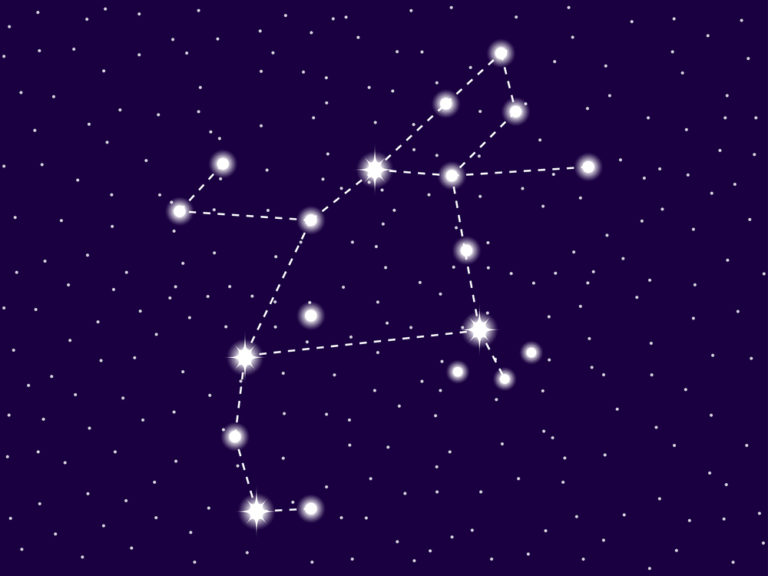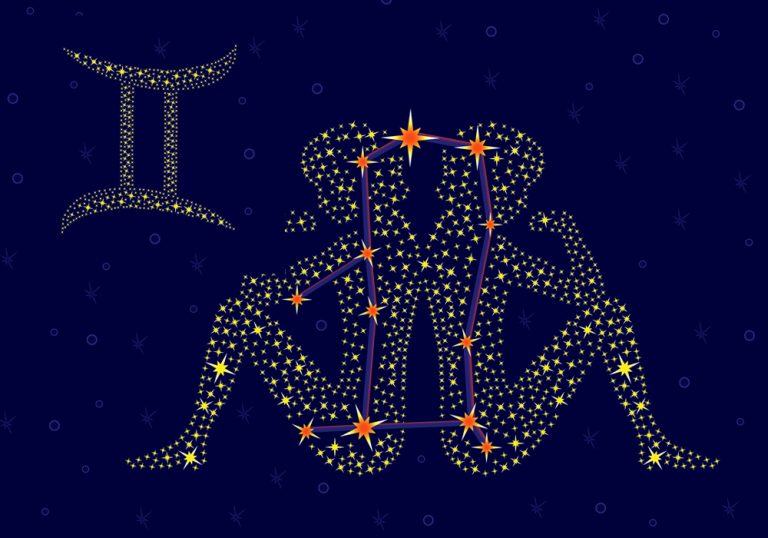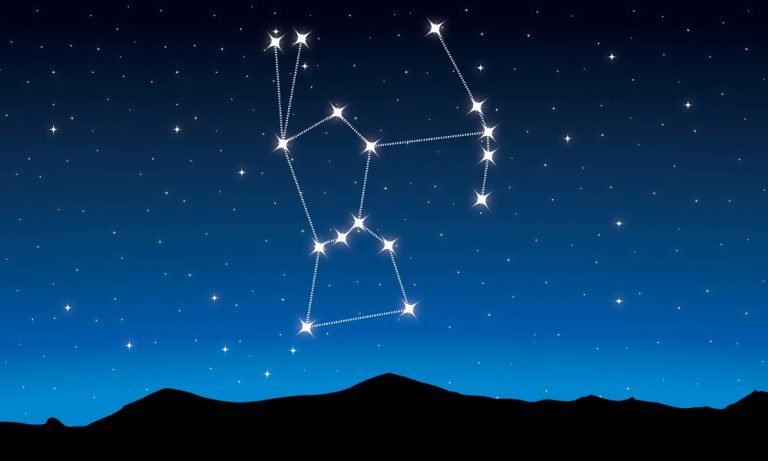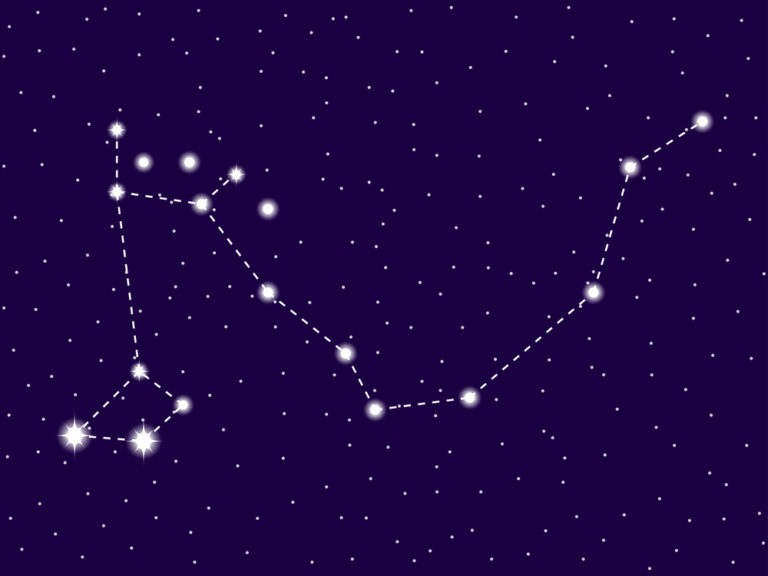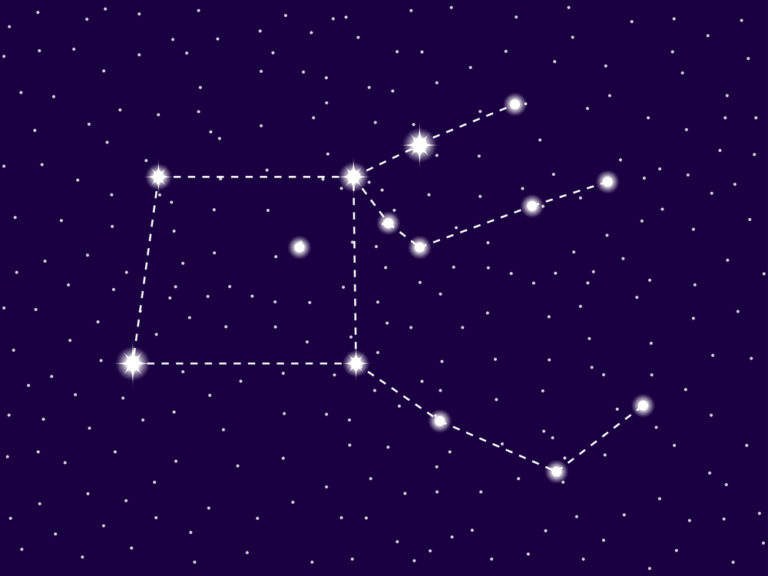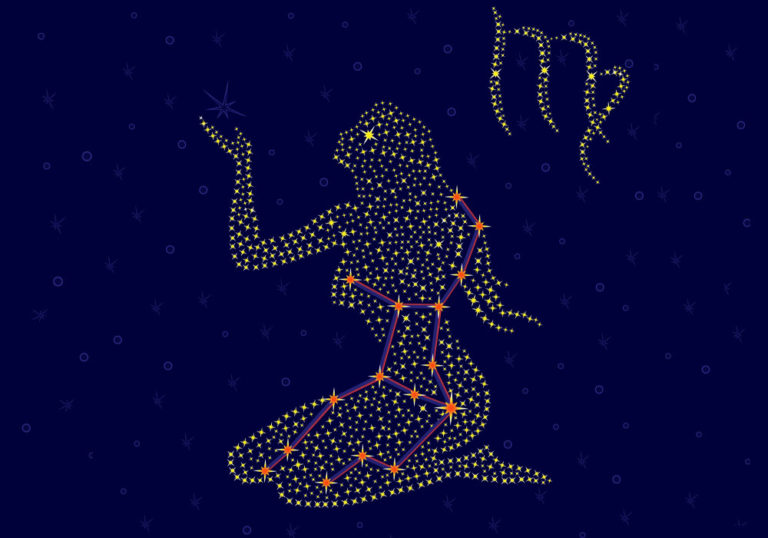Cassiopeia Constellation: Stars, Myth, and Location (2024)
Object name: Cassiopeia Constellation
Abbreviation: Cas
Symbolism: The Seated Queen
R.A. position: 22h 57m 04.5897s – 03h 41m 14.0997s
Dec. position: 77.6923447° – 48.6632690°
Distance from earth: The average distance is 268 light-years
Area: 598 sq. deg.
Brightest star: Schedar (α Cas)
Visible at: Latitudes between +90° and −20°
Best viewed: During the month of November at 9.00pm
The Cassiopeia constellation is the 25th largest in the sky. It is also known as the Seated Queen. It is an ancient constellation that dates back to Greek times and is associated with a vain and arrogant Queen who eternally circles around the Celestial North Pole on her throne.
Cassiopeia can be found in the sky by locating Andromeda, her daughter, and Cepheus, her husband. Cassiopeia is an exciting constellation to explore, offering the spectacular Messier 52 galaxy.
Read on to learn more about the constellation Cassiopeia and interesting Cassiopeia facts.
- Characteristics
- Features
- Location and visibility
- History of observation
- Mythology and meaning
- Future
Characteristics
Cassiopeia is a medium-sized constellation located in the northern celestial hemisphere. It has 5 bright stars that form a distinctive W-shape that is easy to recognize. These stars have fascinating names like Schedar, Caph, Ruchbah, Segin, and Achird.
Cassiopeia comes from the Greek myth of a beautiful Queen who could not contain her vanity and arrogance. After boasting that she was more beautiful than the Sea Nymphs, her punishment was to circle endlessly in the sky, sitting on her golden throne.
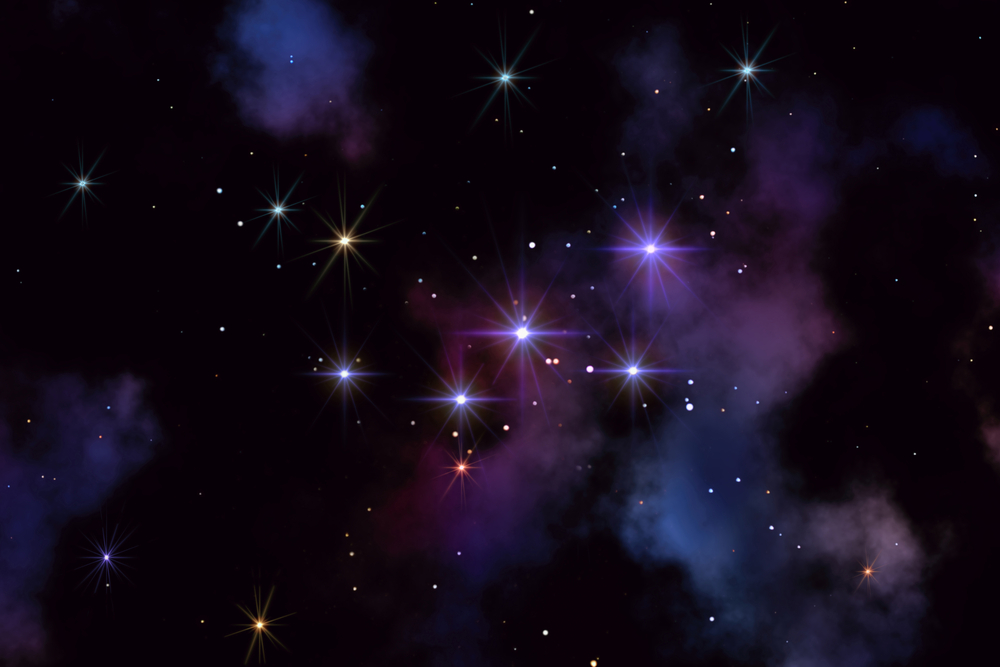
Cassiopeia belongs to the Perseus family of constellations. These include Lacerta, Pegasus, Andromeda, Auriga, Perseus, Cepheus, Cetus, and Triangulum. They all feature in myths relating to Perseus, the Great Warrior.
The Cassiopeia (constellation) occupies an area of 598 square degrees. The neighboring constellations are Cepheus, her husband, King of Ethiopia, Perseus, and Andromeda, her daughter.
For home astronomers, there are many fascinating Cassiopeia constellation facts. It contains the spectacular White Rose Cluster and the fun Pacman Nebula, which gets its name from the computer game. The Cassiopeia symbol is a beautiful queen on a throne. The Cassiopeia constellation story dates back over 3000 years (1).
What does Cassiopeia constellation look like?
Okay, but what does Cassiopeia look like?
Cassiopeia is a beautiful Queen, sitting on a throne. In some images, she holds a hairbrush in one hand and a mirror in the other. In another Cassiopeia story, she has one hand in her hair and a palm frond in the other.
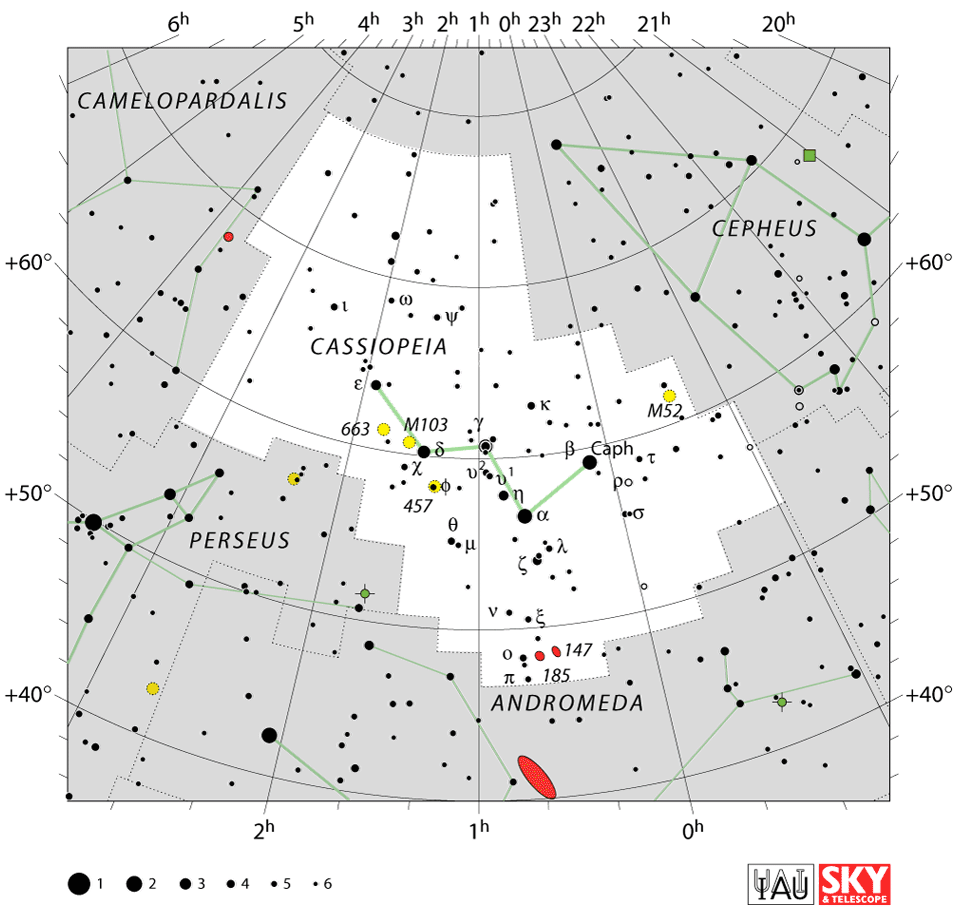
In the sky, the constellation Cassiopeia is a full female figure, pinpointed by major stars. The stars pinpoint her breast, elbow, girdle, and knees. She sits on a huge chair that resembles an ornate throne.
Cassiopeia’s head points to the Northern Celestial Pole, and she circles around it endlessly. In fact, for half the year, she sits upside down. This was her punishment for her vanity and arrogance in proclaiming how beautiful she and her daughter were.
Cassiopeia is sometimes bound into the chair with ropes, so she can never escape. Some stories prefer not to show the ropes. Her feet rest on the floor and her hands are lifted up. Her back rests against the large back of the throne.
To complete the image of Cassiopeia, imagine her with long tresses of dark hair. Dress her in a long flowing robe and place leather thongs on her feet. Finish the throne a luxurious gold, with plush red velvet seating. Then send the Queen circling endlessly in the sky – try not to get dizzy. (2).
How far is Cassiopeia constellation from earth?
When viewing a constellation from Earth, it appears as if all the stars and celestial bodies are on one flat plane. In reality, this is not correct! They all lie at different distances away, measured in light-years. Some stars may be as close as 40 light-years. Deep-sky objects may be as far as 60 million light-years away.
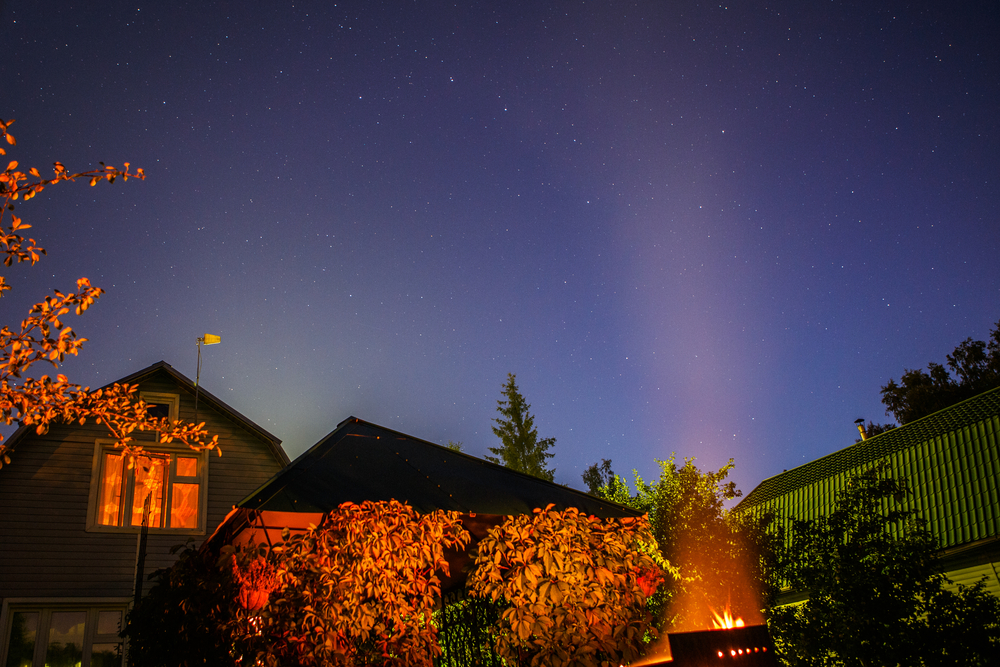
To give some idea, Schedar, also known as Shedir, is an orange giant that lies about 228 light-years away. Beta Cassiopeiae lies about 54.5 light-years away from Earth. Gamma Cassiopeiae is the central star in the W shape and lies about 610 light-years away.
Ruchbah is closer at 99 light-years away. Achird is a binary star system and is the nearest to our solar system, at only 19.4 light-years away. Zeta Cassiopeiae is a blue-white subgiant that lies about 600 light-years away.
Much further away is Messier 52, an open cluster at about 5,000 light-years. Messier 103 lies about 10,000 light-years from and the famous Pacman nebula lies 9,500 light-years from Earth.
Taking into account the brightest stars and their individual distances, the average distance to the Cassiopeia constellation from Earth is about 268 light-years. If you consider the deep-sky galaxies, the distance is around millions of light-years!
Features
Major stars in Cassiopeia
Many stargazers often ask “how many stars are in the constellation Cassiopeia?” There are thousands!
Here is a list of the Cassiopeia major stars.
Schedar (Shedir) – α Cassiopeiae (Alpha Cassiopeiae)
Schedar, also known as Shedir, is an orange giant that lies about 228 light-years away from Earth. It is a variable star with an apparent visual magnitude that varies between 2.20 to 2.23. The traditional name comes from the Arabic şadr, which means “breast.”
The star lies at the breast of the Queen and at the bottom right of the W asterism. Schedar is one of the 58 bright stars selected for use in navigation. Navigational stars have a special status in the sky as they are bright and easy to identify. Alpha Cassiopeiae is Cassiopeia brightest star (3).
Caph – β Cassiopeiae (Beta Cassiopeiae)
Beta Cassiopeiae lies about 54.5 light-years away from Earth. It is a white giant with an apparent visual magnitude of 2.28. Caph is the 3rd brightest star in Cassiopeia. Caph has an average apparent visual magnitude of 2.27. Its traditional name comes from the Arabic kaf, which means “palm”, as in ‘palm of the Pleiades’ or ‘reaching from the Pleiades’.
The star is also known as al-Sanam al-Nakah or Beta Cassiopeiae. It lies on the back of the throne. Caph is a yellow-white star, 28 times brighter than our Sun and four times the size. It is currently cooling down and will eventually become a red giant (4).
γ Cassiopeiae (Gamma Cassiopeiae)
Gamma Cassiopeiae is the central star in the W shape and lies about 610 light-years away. Due to the variable magnitudes of this star and that of alpha Cassiopeiae, this star sometimes outshines Schedar to become the brightest star in Cassiopeia. It is a blue-white subgiant star and is 34,000 times more luminous than the Sun.
It has a mass of 15 times that of the Sun. It shows irregular variations in brightness, ranging between 2.20 and 3.40 magnitudes. The star is also known as Navi, a name it got from the American astronaut Virgil Ivan Grissom on his Apollo 1 mission. Ivan spelled backward is Navi (5).
Ruchbah – δ Cassiopeiae (Delta Cassiopeiae)
Ruchbah or Delta Cassiopeiae is an eclipsing binary star with an orbital period of 460 days. It lies about 99 light-years away. The star has a variable apparent visual magnitude between 2.68 and 2.74. It is the fourth brightest star in the queen constellation.
The star’s traditional name comes from the Arabic rukbah, which means “the knee”. The star lies at the knee of the Seated Queen. Ruchbah has a surface temperature of 8,400 K, which is warmer than our Sun (6).
Segin – ε Cassiopeiae (Epsilon Cassiopeiae)
Segin, or Epsilon Cassiopeiae, is a bright blue-white giant that lies about 440 light-years away from Earth. It has an apparent visual magnitude of 3.34 and you can see it without using a telescope.
The star is 2,500 times more luminous than the Sun. Segin lies below the left knee of the queen. The star is around 65 million years and is reaching the end of its hydrogen-fusing cycle. Segin is the 5th brightest star in the constellation and is the faintest of the 5 stars in the W-shape (30).
Achird – η Cassiopeiae (Eta Cassiopeiae)
Achird is a binary star system, first discovered in 1779 by William Herschel. It is the nearest star in Cassiopeia to our solar system, only 19.4 light-years away. Archird is a yellow-white dwarf, very similar to our Sun.
It has a surface temperature of 5,730 K and an apparent visual magnitude of 3.45. The dimmer companion is an orange dwarf with an apparent visual magnitude of 7.51. Achird lies at the girdle of the Queen, in the middle of her body.
ζ Cassiopeiae (Zeta Cassiopeiae)
Zeta Cassiopeiae is a blue-white subgiant that lies about 600 light-years away from Earth. It has an apparent visual magnitude of 3.67. Zeta Cassiopeiae is a Slow Pulsating B star, also known as a SPB variable star.
The star is also known as Fulu, from the Chinese name Fùlù, meaning ‘the auxiliary road’. Fulu is far hotter than our Sun, with a surface temperature of 20,430 K (7).
Deep-sky objects in Cassiopeia
Messier 52 (NGC 7654)
Messier 52 is an open cluster that lies about 5,000 light-years away from our Solar System. It has an apparent visual magnitude of 5.0. The cluster is around 35 million years old and is 19 light-years in diameter.
Messier 52 contains 193 probable members. Discovery was in 1774, by Charles Messier. The brightest stars in the cluster are two yellow giants of magnitude 7.77 and 8.22. The cluster lies between the head of King Cepheus and his daughter’s throne (8).
Messier 103 (NGC 581)
Messier 103 is an open cluster that lies about 10,000 light-years from Earth. It contains around 172 stars and is one of the smallest and most remote open clusters known. The age of the cluster is about 25 million years.
Discovery was in 1781, by the French astronomer Pierre Méchain. The diameter of the cluster is around 17.5 light-years. For home stargazers, Messier 103 is easy to find. It lies within the familiar W-shape, to the east of Ruchbah, the bottom left star of the W (9).
Cassiopeia A
Cassiopeia A is a supernova remnant and is famous for being the strongest source of radio emission in the sky, outside of our Solar System. It lies about 11,000 light-years away. The light from the explosion probably reached earth between 1662 and 1700.
The cloud of material ejected from the explosion extends for about 10 light-years across and is expanding at the rate of 4,000 to 6,000 km/s. At the center of the remnant is a neutron star, which was the first detected to have a carbon atmosphere (10).
The Pacman Nebula – NGC 281
The Pacman Nebula is also known as NGC 281. The name comes from the shape, which resembles the character in the well-known video game. NGC 281 is a massive, active star-forming region.
It contains large amounts of ionized atomic hydrogen, lit by the ultraviolet light of young, hot, blue stars. This creates the spectacular images seen in the photo. The Cassiopeia nebula lies 9,500 light-years from Earth. It was discovered by American astronomer E.E. Barnard in 1883 (11).
The White Rose Cluster (NGC 7789)
NGC 7789 is an open star cluster, about 7,600 light-years away.
It has an apparent magnitude of 6.7. The cluster is also known as Caroline’s Rose or The White Rose because the pattern of stars resembles rose petals. The cluster is around 1.6 billion years old and has a diameter of over 50 light-years.
According to astronomers, all the stars in the cluster were probably born at the same time. The brighter ones have more rapidly exhausted the hydrogen fuel in their cores and evolved from main-sequence stars into red giants. This Cassiopeia galaxy was discovered by the British astronomer Caroline Herschel in 1783 (12).
NGC 185 (Caldwell 18)
NGC 185 is a dwarf spheroidal galaxy. It lies about 2.08 million light-years from Earth. It is atypical for a dwarf elliptical galaxy, as it contains young clusters of stars that show evidence of star formation occurring recently in the cluster.
It is a satellite galaxy of Messier 31, the Andromeda Galaxy. The galaxy was discovered by the English astronomer John Herschel, Caroline Herschel’s brother, in 1787.
NGC 147 (Caldwell 17)
NGC 147 is a dwarf spheroidal galaxy in Cassiopeia. It lies about 2.53 million light-years away from our Solar System. It is also a member of the Andromeda Galaxy, Messier 31. NGC 147 has an apparent visual magnitude of 10.5. Discovery was in 1829, by John Herschel.
NCG 147 is also known as Caldwell 17. The Caldwell catalog is an astronomical catalog of 109-star clusters, nebulae, and galaxies. The list was compiled by Patrick Moore (using his other surname) as a complement to the Messier catalog.
Exoplanets in Cassiopeia
Exoplanets are planets that revolve around stars, other than our star, the Sun. Exoplanets excite astronomers as they may offer conditions similar to those in our Solar System, with the possibility of life.
HD 17156
HD 17156 is also known as Nushagak. It is a yellow star about 244 light-years away from Earth. It has one exoplanet named Mulchatna. This is a gas giant with a mass of 3.51 Jupiters. It takes 21.2 days to complete one orbit of its star.
The star and exoplanet were named by a woman from Dillingham, Alaska. She chose the names after the rivers where she grew up in Bristol Bay. The International Astronomical Union’s U.S. committee selected the names from almost 900 entries around the country (13).
HD 104985
HD 104985 is also known as Tonatiuh. It is a yellow giant about 316 light-years away from Earth. It has one exoplanet called Meztli or HD 104985 b. This is a gas giant exoplanet that orbits its mother star every 199.5 days. It has a mass of 8.3 Jupiters.
The objects got their names during the July 2014 International Astronomical Union program for members of the public to name exoplanets. The winning name came from the Sociedad Astronomica Urania of Morelos, Mexico. Meztli is the Aztec goddess of the Moon (14).
Meteor showers in Cassiopeia
Meteor showers occur when Earth crosses the orbital path of a comet. Dust and debris from the remnants of the comet enter the Earth’s atmosphere and burn up. This creates a spectacular show, often known as shooting stars.
The Beta Cassiopeids
This shower takes place within the boundaries of the constellation of Cassiopeia. The meteor shower occurs between 3 July and 19 August with the peak occurring on 29 July. The closest star to the radiant point of the meteor shower is Caph. You can expect to see about 10 meteors per hour traveling at speeds of 52km/s.
The Perseids
Although the Perseids meteor shower comes from the constellation Perseus, it also belongs to Cassiopeia the queen constellation. The radiant point lies between the two in the sky and the meteors shoot out in all directions, adding beauty to the already vain queen Cassiopeia.
The Perseids are one of the most famous meteor showers. Cassiopeia mythology tells that the shower comes from the fiery battle that took place when Perseus beheaded the dreaded Gorgon monster, Medusa. The shower occurs between 17 July to 24 August, with the peak on 13 August.
Expect to see over 50 per hour, traveling at speeds of up to 60km/s. The comet of origin that creates this amazing show is 109P/Swift-Tuttle. This comet got its name from the two astronomers who discovered it. Comet 109P/Swift-Tuttle orbits the Sun every 133 years. It appeared in 1992 and will return in 2125. It is a large comet with a nucleus size of 16 miles (15).
Location and visibility
Where is Cassiopeia constellation located?
Cassiopeia is a medium-sized constellation with 5 bright stars in a well-known W-shape. You can easily spot it once you know what to look for. In dark skies, you can see the main stars without a telescope. Then, you can imagine the beautiful Queen, sitting in her chair, endlessly fixing her hair as punishment for her vanity.
Where is Cassiopeia in the sky?
Cassiopeia is a northern constellation and is the 25th largest constellation of the 88 named constellations. It occupies an area of 598 square degrees. Cassiopeia lies in the first quadrant of the northern hemisphere, NQ1.
A quadrant is essentially a quarter of a circle, which allows astronomers to measure the altitude of objects above the horizon. You can see the constellation at latitudes between +90° and −20°.
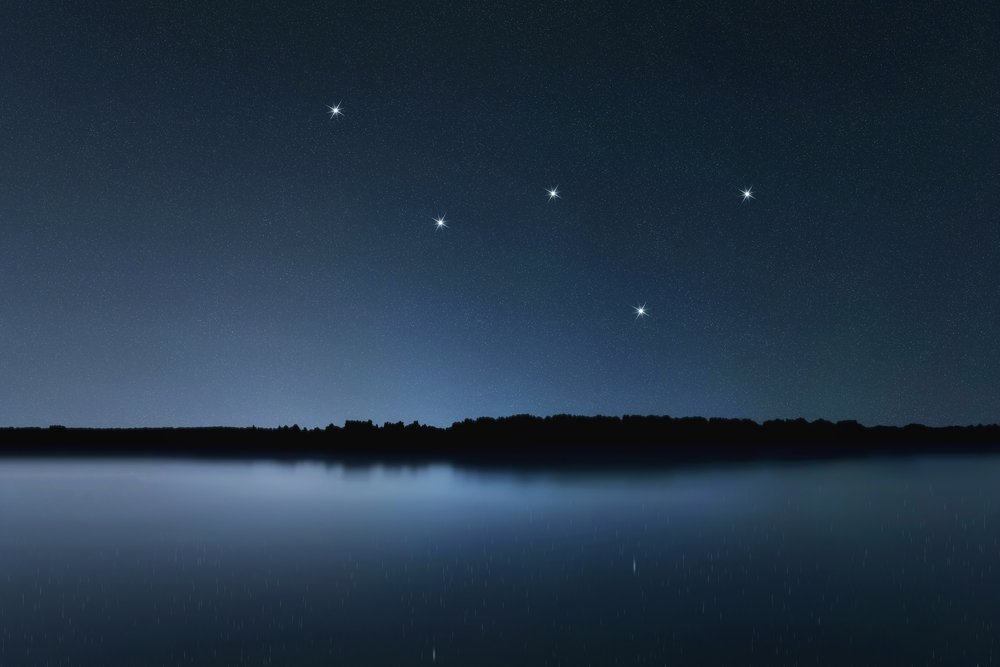
To find the Cassiopeia location, you can find the two constellations of
Perseus the Great Warrior, and Andromeda, the Chained Woman.
Cassiopeia and Perseus are close together in the sky.
The head of Perseus lies near to the leg of the Queen. The Queen looks at the lower legs of Andromeda, when she is not admiring her image in the mirror! On the northern side of the Queen, is another famous constellation near Cassiopeia. It is Cepheus, her husband, the King of Ethiopia (16).
When is Cassiopeia constellation visible?
When is Cassiopeia visible? Cassiopeia is visible all year round in the northern hemisphere. In the southern hemisphere, she appears very low on the horizon only in November and December.
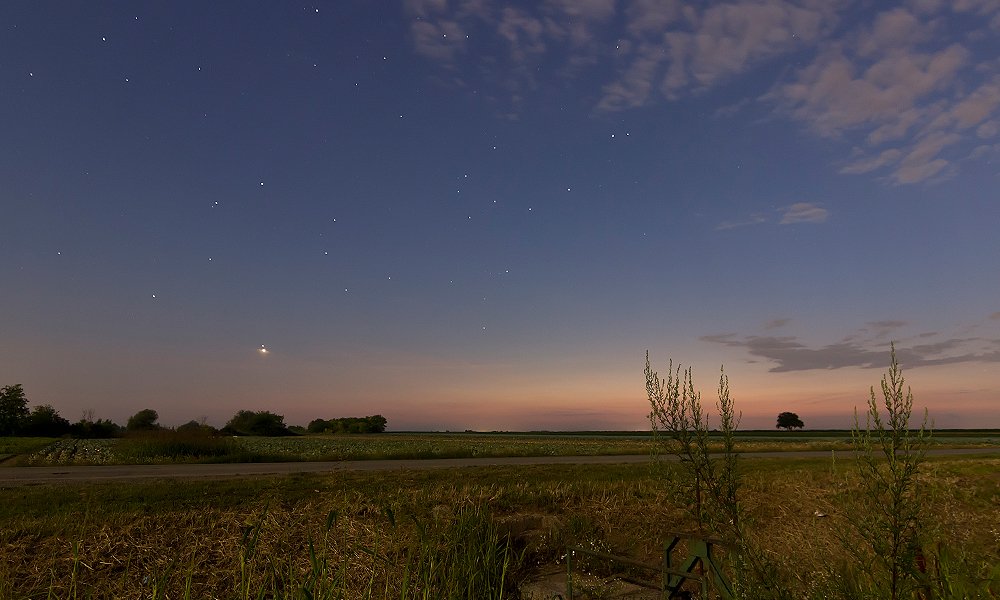
Northern hemisphere
If you are in the northern hemisphere – In January, February and March the constellation appears almost overhead at around 6pm. This is the perfect time to take the kids out for some stargazing to learn about the Cassiopeia constellation story. As the evening progresses it will move down towards the horizon in a north-westerly direction.
In April, May and June, Cassiopeia is visible low on the horizon in a northerly direction at around 9pm. In July, August and September, the constellation is visible from around 10pm in a northerly or north-easterly position. From October to December it appears high in the sky in the north-east at around 6pm, moves overhead, and then dips towards the north-west horizon.
Southern hemisphere
In the southern hemisphere – The queen constellation only appears in November and December. Look very low on the horizon at around 10pm in a northerly direction. She is visible for a few hours, and then moves westwards before dipping below the horizon between 1am and 3am (17).
How to find Cassiopeia constellation?
The Cassiopeia 5 star constellation is best viewed in the northern hemisphere, where it can be seen all year round. In the southern hemisphere, you can see the w shaped constellation low on the horizon, only in November and December.
Northern Hemisphere
Read on to learn how to find the star constellation Cassiopeia.
- To find the Cassiopeia location, it is easiest to first find the Big Dipper in Ursa Major, the Great Bear
- Then star-hop across to Polaris, the bright North Star
- Draw an imaginary line from any Big Dipper handle star through Polaris, double the distance and you will land on the Cassiopeia letter W
- You can also find Cassiopeia’s chair from the other side
- Locate the Great Square of Pegasus
- Then locate Andromeda the Chained Woman, below and to the right
- The well defined W-shape of Cassiopeia lies to the right of the two
Southern Hemisphere
- To find the Cassiopeia location, it is easiest to first find the Big Dipper in Ursa Major, the Great Bear
- Then star-hop across to Polaris, the bright North Star
- Draw an imaginary line from any Big Dipper handle star through Polaris, double the distance and you will land on the M-shaped constellation Cassiopeia
- You can also find Cassiopeia chair from the other side
- Locate the Great Square of Pegasus
- Then locate Andromeda the Chained Woman, below and to the left
- The well defined W-shape of Cassiopeia lies to the left of the two
- Because queen Cassiopeia constellation is so low on the horizon, it can be difficult to spot unless you have really dark skies and a clear view
How to view Cassiopeia Constellation?
Cassiopeia is the 25th largest constellation in the sky. It has a well-defined star pattern or asterism, that resembles a W-shape or an M-shape, depending on when you see it. By locating these stars, you can imagine the queen constellation in the sky.
Like all stargazing experiences, getting away from city lights is the best way to see constellations and deep-sky objects. You can see the five-star constellation with the naked eye, but using a telescope will make it so much more exciting.
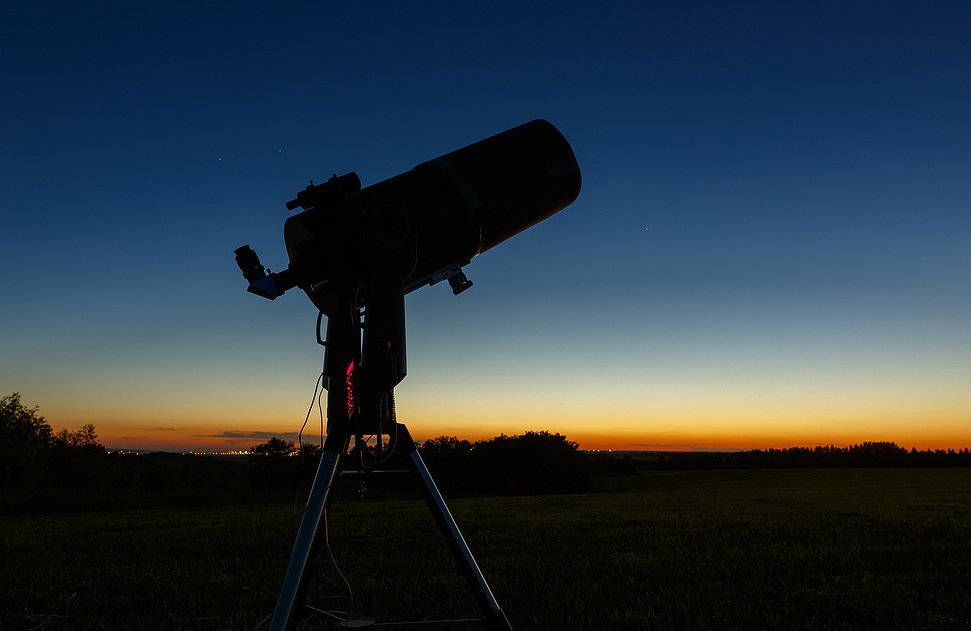
For amateurs, there is a great choice of well-priced scopes that will give you fabulous images of Cassiopeia in the sky.
Depending on your budget, plan to spend from $250 to $900 on a telescope that will give a lifetime of viewing.
The Orion Apex 102mm Maksutov-Cassegrain Telescope comes in a stylish burgundy color. It is extremely compact and fits easily into a backpack, ideal for weekend stargazing in the country. Despite the small size, it has the power of a traditional scope five times its size.
It is perfect for viewing the stars in Cassiopeia and a great opportunity for the kids to learn about the mythology of Cassiopeia. The telescope has a 102mm aperture and a focal length of 1300mm. It comes in a soft travel case. Included is a 25mm Sirius Plossl 1.25″ eyepiece, a 45-degree correct-image diagonal, and a 6×26 correct-image Finderscope.
This scope does not include a mount. You will need to purchase the mount separately. At under $250 the Orion Apex 102mm Maksutov-Cassegrain Telescope is a great choice for a family hobby.
History of observation
Who discovered Cassiopeia constellation?
Cassiopeia history dates back to ancient civilizations of the Greeks, Chinese, Arabians, and Welsh mythology, and was documented in stories, folklore, and myths.
The greek princess constellation dates as far back as 3000BC. It associates with the beautiful Queen Cassiopeia, wife of King Cepheus. As a result of her vanity, she claimed that she was more beautiful than the sea nymphs, the Nereids. Poseidon, King of the Sea was furious by this, and she was forced to sit in the sky, in a chair, brushing her hair for all eternity (18).
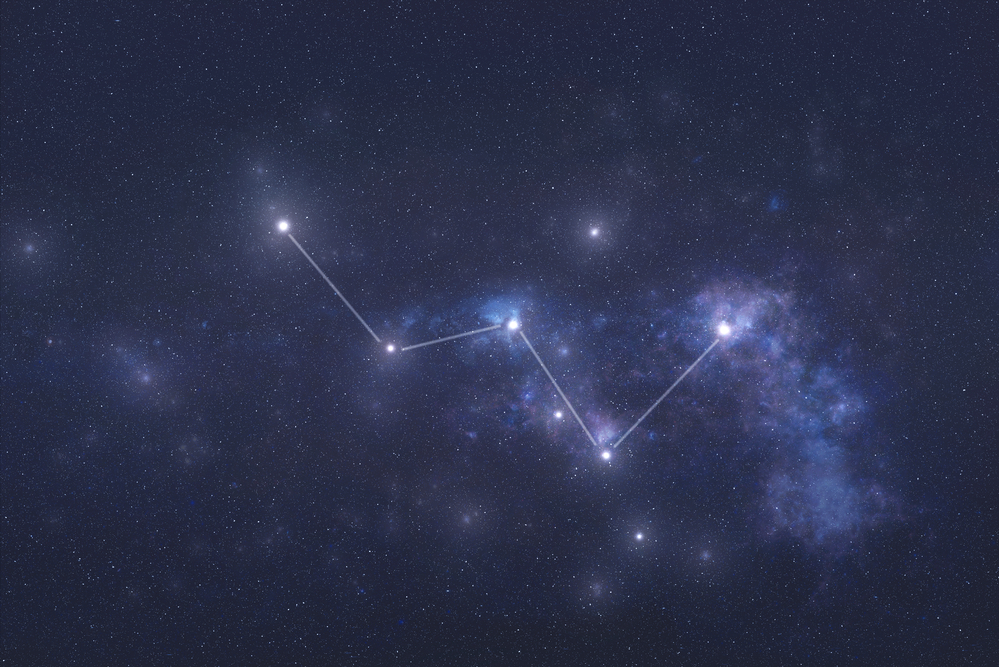
Here are some more fascinating Cassiopeia facts. This beautiful artwork in the Louvre shows the King of Ethiopia Cepheus and Queen Cassiopeia thanking Perseus for saving Andromeda – “La Délivrance d’Andromède (1679) Pierre Mignard, Louvre”
The Cassiopeia stars also feature in Chinese astronomy dating back to 750BC. The Chinese astronomers saw several figures in the sky. Kappa, Eta, and Mu Cassiopeiae form a constellation called the Bridge of the Kings. When combined with Alpha and Beta Cassiopeiae, they form the great chariot Wang-Liang.
Around 500BC, Celtic myths told of Llys Dôn, “The Court of Dôn”. This is the traditional Welsh name for the constellation (19).
During the Islamic Golden Age, the 9th to 13th centuries, Arabian astronomers knew of the Cassiopeia constellation stars. They formed the shape of a camel. Its head is Iota, Lambda, Kappa, and Phi Andromedae. The hump is Beta Cassiopeiae. The body is the remaining stars in Cassiopeia, and the legs are the stars in Perseus and Andromeda (20). The Lapps from Lapland, see the W-shape of Cassiopeia constellation as antlers of the elk.
In more recent times, the famous astronomer Ptolemy officially named the constellation Cassiopeia. He lived between 90 AD and 168 AD.
How old is Cassiopeia constellation?
The Mercator projection is a cylindrical map projection presented by Flemish geographer and cartographer Gerardus Mercator in 1569.
Cassiopeia is one of the ancient female constellations that date back to the era of Greek mythology around 3000BC. The constellation depicts the myth of Queen Cassiopeia, wife of King Cepheus, King of Ethiopia.
The queen was beautiful but vain and boasted that she was more beautiful than the Nereids the Sea Nymphs. Poseidon, God of the Sea in his fury sent floods to destroy the King’s lands and he had to offer their beautiful daughter Andromeda as a sacrifice.
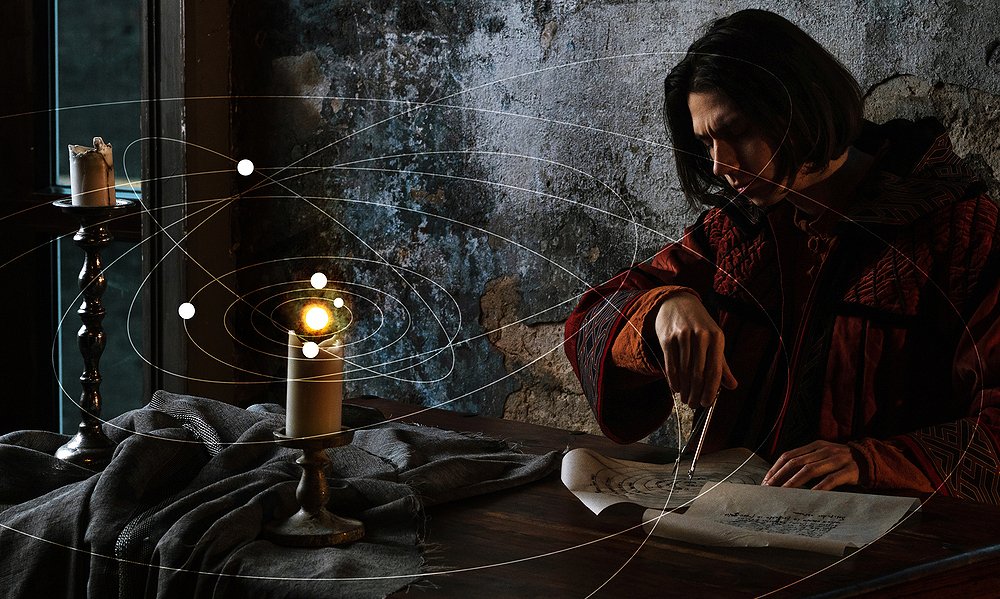
In Chinese Cassiopeia constellation history, astronomers knew the star pattern as far back as 750BC. The stars forming the constellation Cassiopeia are found in three areas – the Purple Forbidden enclosure, the Black Tortoise of the North, and the White Tiger of the West.
Arabian astronomers also discovered Cassiopeia. Atlases in the Islamic Golden Age, 9th to 13th centuries, depict a camel constellation incorporating Cassiopeia constellation stars. (21). Ancient civilizations of Hawaii knew the constellation as ‘Iwa Keli‘i – Chief Frigate Bird. ‘Iwa’ refers to the M or W-shaped figure in the constellation. The Frigate Bird, soaring in the sky has an M or W shape (22).
What is Cassiopeia in Biblical times? Revelations, written by John the Elder, around 96AD, referred to the Throne of God. This was probably the constellation Cassiopeia, depicted as a throne (23).
How did the Cassiopeia constellation get its name?
Most constellations get their names from ancient cultures, folklore, or mythology. So, what is the Cassiopeia meaning and how did Cassiopeia get its name?
The word Cassiopeia is the name of the Queen of Ethiopia, wife of King Cepheus, from Greek Cassiopeia myths. As a result of her vanity, she sits in the sky, endlessly circling the North Celestial Pole, upside down for half of the year.
Stargazers may ask – what does Cassiopeia mean in Greek? Cassiopeia’s name in Greek is Κassiope, which means “she whose words excel”. Greeks also know it is Kassiepeia E tou thronou, ‘Cassiopeia, She of the Throne’.
The constellation is often referred to as Cassiopeia’s throne because the stars clearly outline a chair, or a throne, upon which the queen sits.
The Cassiopeia name features in the world of living creatures. Cassiopea is the name of the genus of the “upside-down” jellyfish. The adult stage of a jellyfish is the ‘medusa’, also related to Greek mythology and the story of Cassiopeia. In Spanish, a jellyfish is a Medusa.
How is Cassiopeia pronounce? According to the Chambers 20th Century Dictionary, it is kas-i-ō-pē′ya, – a constellation in the northern hemisphere, near the North Pole, named after the mother of Andromeda in Greek mythology (24). The Cassiopeia nickname or abbreviation is Cas.
Mythology and meaning
Cassiopeia myth
In the myth of Cassiopeia, she is Queen of Ethiopia, wife of King Cepheus. They had a beautiful daughter, Andromeda. Although Cassiopeia was very beautiful she was extremely vain.
One day, she boasted that she and her daughter were more beautiful than the sea nymphs, the Nereids. This enraged the nymphs, and they appealed to Poseidon to punish her. Poseidon’s wife was a nymph, Amphitrite, and he was greatly angered by Cassiopeia’s comments.
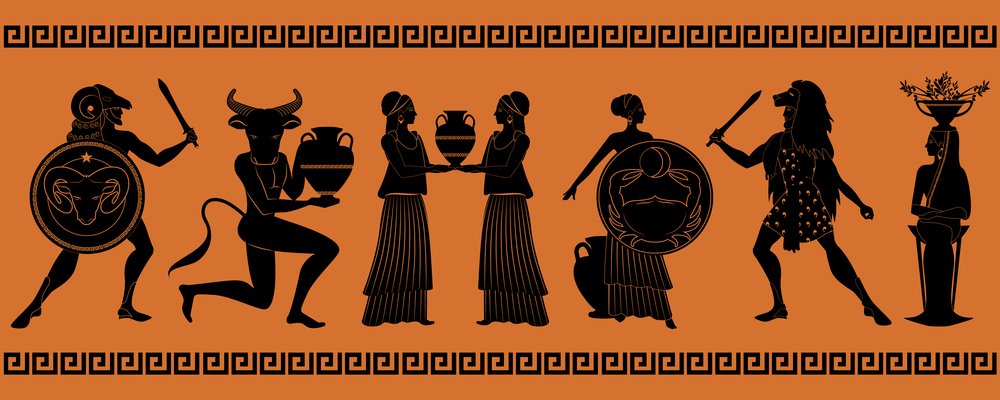
Poseidon sent Cetus, the sea monster to ravage the lands of the King by causing massive floods and deluges. In desperation, Cepheus turned to an oracle for help. The oracle told him that, to appease Poseidon, he and Cassiopeia had to sacrifice their daughter Andromeda to the sea monster.
Andromeda is also a famous character in Cassiopeia greek mythology and is a greek princess constellation. In the Cassiopeia myth, the King reluctantly obeyed the Oracle’s instructions, chaining Andromeda to rock for the monster to find. Perseus, the great hero, saw her in the ocean and rescued her from death. Perseus and Andromeda then married.
Poseidon was angry that Cassiopeia was not punished. He placed her in the sky, sitting in a chair revolving endlessly around the north celestial pole. Cassiopeia constellation mythology depicts her brushing her hair forever, revolving upside down for half the year as punishment for her vanity.
Cassiopeia and Orion are unrelated in Greek Mythology. Cassiopeia relates to Perseus, who rescued her daughter Andromeda (25).
What does Cassiopeia symbolize?
From the above picture, it is easy to see what the Cassiopeia symbol is. She is a beautiful Queen, sitting on her golden throne, with her hand in her hair. But, it is not always as it appears. In fact, in the story of Cassiopeia, she is bound hands and feet into the chair and can never escape.
This is due to her arrogance and vanity. She boasted to the Sea Nymphs, the Nereids, that both she and her daughter, Andromeda were more beautiful than they were. Andromeda was sacrificed to save the King’s Lands, but Perseus saved her.

Cassiopeia, however, was unpunished. This enraged the Sea God, Poseidon. He placed her in a chair that endlessly circles the Celestial North Pole, causing her to sit upside down for half the year.
If Cassiopeia visits you in your dreams, you are prone to show off and become vain. Take care and take note. You may hurt someone close to you, as the Queen did to her daughter. Beauty and power is a gift and should not be taken lightly. Vanity and arrogance are not qualities that you want to bring into your life.
Andromeda had to suffer for her Mother’s foolishness. King Cepheus also had to suffer for her vanity. The Cassiopeia constellation meaning is very clear – think before you show off as you can cause harm to others, and you will eventually pay the price, just like Cassiopeia.
Future of Cassiopeia constellation
The Cassiopeia star constellation has many stars in various stages of their lives that can teach astronomers about the future of the universe.
Eta Cassiopeiae A is very similar to our Sun and has already lived approximately half of its life. Eta Cassiopeiae A will one day become a red giant. Because it has a close companion, Eta Cassiopeiae B, this star will be adversely affected – how and when is still difficult to predict (26).
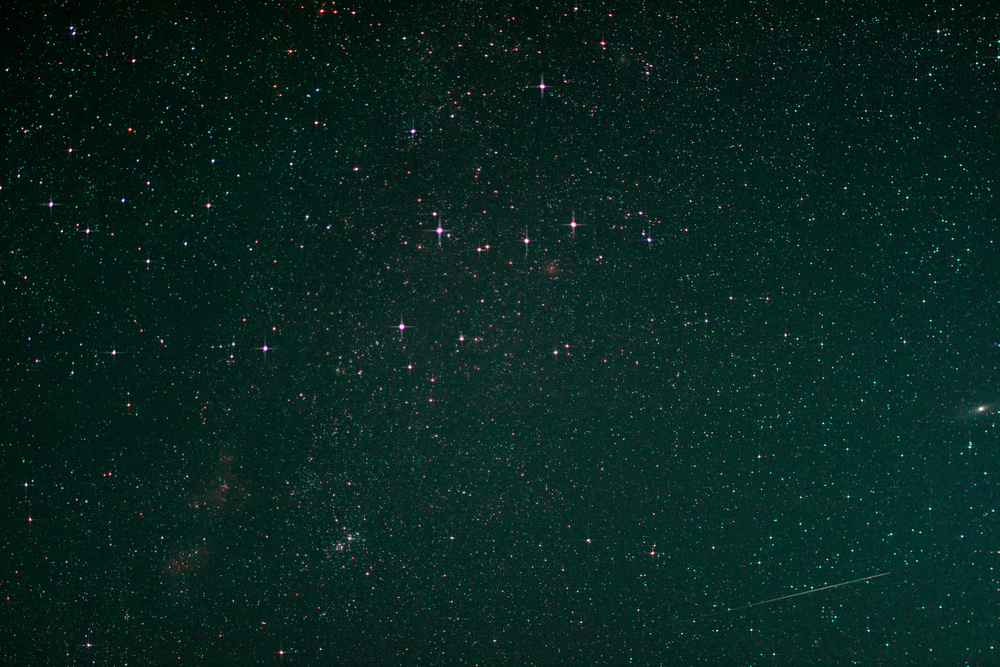
Using VR (Virtual Reality) technology, scientists are able to step inside the Supernova Remnant Cassiopeia A. Cassiopeia A is the youngest known supernova remnant in the Milky Way, which exploded only 400 years ago.
“A team led by Kimberly Kowal Arcand from the Harvard-Smithsonian Center for Astrophysics (CfA) and the Center for Computation and Visualization at Brown University has made it possible for astronomers, astrophysicists, space enthusiasts, and the simply curious to experience what it’s like inside a dead star”. This will become a spectacular method to study the universe in the future (27).
Scientists have also detected a unique star in the constellation Cassiopeia. The merger of two massive white dwarfs has created a rapidly rotating and highly magnetized super-Chandrasekhar-mass white dwarf. This star will collapse into a type Ic supernova within several thousand years (28).


